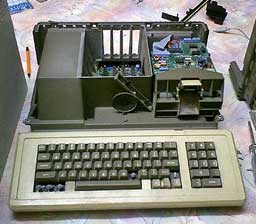Apple III Failure: A Lesson in Design Flaws and Business

The Apple III failure remains a pivotal moment in the history of personal computing, marked by significant missteps that ultimately led to its downfall. Launched in May 1980, the Apple III was intended to be a robust business computer, but it was plagued by an overheating issue that severely compromised its reliability. Apple CEO Mike Markkula openly admitted the design flaws related to the Apple III motherboard, a revelation that exacerbated the computer’s already troubled reception. In an ironic twist, the company suggested a bizarre workaround: to drop the device to reseat its problematic chips. This unorthodox approach only highlighted the confusion surrounding Apple’s computer business strategy and the overwhelming pressure to outpace competitors like IBM in the burgeoning market.
The notorious failure of the Apple III is emblematic of the challenges faced by Apple during the early 1980s. Designed with ambitious features, this model was envisioned as a powerful machine for business applications. However, it quickly became known for its critical overheating problems, primarily attributed to its flawed motherboard. As discussions surrounding the device’s performance evolved, it became clear that Apple was desperately trying to address numerous design flaws. The Apple III serves as a cautionary tale about the importance of coherent product strategy and the consequences of feature overload in technology development.
The Rise and Fall of the Apple III
The Apple III’s journey began with high hopes and significant investment in May 1980. Designed as a business computer, this successor to the successful Apple II was meant to capitalize on the booming computer market. However, it quickly became apparent that the Apple III was plagued by critical issues right from its inception, marking its place in history as Apple’s first major flop. Mismanagement in the development process led to ‘feature creep,’ as various team members pushed for competing elements that diluted the machine’s core identity. The result was a confused product that struggled to find its place in the burgeoning business market.
By April 1981, frustrated by mounting criticism, Apple CEO Mike Markkula candidly acknowledged the shortcomings of the Apple III. The admission highlighted not just a technical failure, but also the broader implications for Apple’s computer business strategy. While the company sought to establish itself firmly in the corporate sector, the Apple III’s flaws left an indelible mark that would shadow Apple’s reputation for years to come.
Understanding the Apple III Motherboard Issues
Central to the Apple III’s lack of success was the infamous motherboard design. The decision to forgo a cooling fan in the machine contributed directly to overheating problems that became legendary within tech circles. Steve Jobs’ insistence on specific aesthetics over technical feasibility led to a design that could not handle the heat produced by its components. As a consequence, users experienced frequent crashes and performance issues, which directly contradicted Apple’s marketing message of reliability and efficiency.
Despite the release of an upgraded model in December 1981 meant to address these motherboard concerns, the damage had already been done. Apple’s unconventional solution to the overheating dilemma—urging users to drop their computers to reseat the chips—embodied a shift in consumer confidence. Such responses only deepened the embarrassment associated with Apple III’s launch and reflected a broader misstep in the company’s approach to engineering and product development.
Apple’s Strategy to Compete with the IBM PC
In an era when the IBM PC was rapidly gaining traction, Apple sought to carve out its niche with the Apple III, emphasizing its capabilities as a business machine. The initial specifications included a robust 2 MHz processor, ample RAM for the time, and built-in floppy disk access, which were intended to appeal directly to corporate consumers. However, the dreamy vision of the Apple III as a corporate powerhouse was undermined by its healing reputation stemming from its underlying hardware issues.
As the firm battled to showcase the Apple III’s features as superior to the IBM PC, the ongoing motherboard debacle exposed significant cracks in its strategy. The Apple II continued to sell well, showcasing the disconnect between the company’s ambition to innovate and the practical reality faced by its customers. The disparity in performance and reliability became a focal point for organizations comparing the machines, eroding any competitive edge the Apple III may have had.
Customer Experiences with the Apple III
The narrative surrounding the Apple III is one filled with frustration and disillusionment for its early adopters. Many customers grappled with the technical failures consistently tied to the overheating motherboard, leading to inquiries about warranty service and repairs. Users found themselves underwhelmed by the promised capabilities of the Apple III against the backdrop of their experiences with the more stable Apple II.
Some owners reported that they felt deceived by Apple’s initial marketing that framed the Apple III as the ideal business machine. For those who navigated the complexities of its operational quirks, such as the unconventional ‘drop to fix’ method, the lack of transparency from Apple fueled anger and disappointment. User experiences highlighted a disconnect between Apple’s corporate aspirations and the realities faced by everyday computer users.
The Legacy of the Apple III
Despite its failure, the Apple III left a complex legacy in the tech industry. Its shortcomings provided important lessons for Apple and the larger computer market about the consequences of rushed production and poor design choices. The failure served as a cautionary tale about prioritizing aesthetics over practical engineering, reminding businesses that user experience should guide product design principles.
In hindsight, the tumult surrounding the Apple III also contributed to a period of introspection at Apple. The company began to refocus its strategy, honing in on the Macintosh project that would eventually redefine personal computing. Apple’s learnings from the Apple III disaster spurred a determined effort to return to their roots of user-centric design, setting the stage for future innovations that would align the company back with its core values.
Technical Specifications of the Apple III
The technical specifications of the Apple III were ambitious for its time. Featuring a SynerTek 6502A processor clocked at 2 MHz and equipped with 128KB of RAM, it was designed to outperform its predecessor, the Apple II. Moreover, the built-in 5.25-inch floppy drive was a groundbreaking addition, allowing for greater data storage and software availability. However, these features were overshadowed by the critical motherboard overheating issue that emerged soon after launch.
Complex hardware configurations and the insistence on design aesthetics often clouded the intention behind Apple III’s capabilities. Each unit built contained potential defects tied to thermal performance that impacted reliability significantly. As these concerns began to snowball, the stated specifications became irrelevant, with many users finding themselves unable to leverage the advanced features as intended.
Apple III’s Place in Computer History
Today, the Apple III holds a notable spot in computer history as an example of ambition clashing with execution. While intended to leverage Apple’s market position in the business sector, its numerous design flaws and the failures in the rollout process ultimately rendered it a textbook case for what can go wrong in product development. It serves as proof of how even well-funded companies can stumble when navigating the increasingly complex landscape of consumer technology.
The narrative of the Apple III encapsulates challenges faced by the tech industry as a whole during the 1980s. Its failures echo in numerous product recalls and iterations, reminding future innovators of the vital importance of grounding design and engineering in user experience. The aftermath of the Apple III failure propelled Apple to pivot towards more user-friendly architectures, particularly leading into the successful launch of the Macintosh.
The Reaction and Criticism over Apple III Launch
The Apple III launch prompted swift and sometimes harsh criticism from both the media and tech enthusiasts alike. Early reviews highlighted the irony of Apple’s marketing versus user experience, particularly noting the discrepancies between the advertised capabilities and realities of use. The media coverage was riddled with reports on the overheating motherboard, leading to widespread skepticism about the Apple III’s viability in business environments.
Apple’s reaction to this criticism, while earnest, revealed a disconnect between its internal assessments and external perceptions. Markkula’s admission of the product’s imperfections only served to fuel dissent among potential buyers. The backlash showcased a pivotal moment in consumer electronics where transparency began asserting itself as a critical component of brand trust, a lesson that continues to resonate in today’s product strategy.
Lessons Learned from the Apple III Mistakes
Looking back at the mistakes made with the Apple III, several critical lessons emerge. Primarily, the importance of robust testing phases before launch becomes evident, as the overheating motherboard issue could have been mitigated with better pre-release evaluations. Additionally, allowing design preferences to dominate engineering considerations can lead to dire consequences—ensuring that user experience consistently informs product design remains crucial in today’s tech landscape.
Moreover, the Apple III debacle taught the broader business community about maintaining clear communication and managing consumer expectations. Apple’s struggle against negative publicity highlighted the need for companies to address product flaws transparently to preserve credibility with their audience. Such lessons remain timeless, impacting technology firms actively striving for long-term customer loyalty and satisfaction.
Frequently Asked Questions
What led to the Apple III failure despite being a business-focused computer?
The Apple III failure can be attributed to various factors, including production delays and an overheating Apple III motherboard. Apple aimed to create a business computer that could compete with the IBM PC, but design flaws, particularly the lack of a cooling fan as insisted by Steve Jobs, led to significant issues that buyers faced from day one.
How did the Apple III motherboard issue affect its market performance?
The overheating Apple III motherboard severely affected market performance, resulting in Apple having to promote unconventional solutions such as asking users to drop their computers. This negative publicity, coupled with high pricing and production delays, contributed to the Apple III’s status as Apple’s first major flop.
What was Apple’s strategy regarding the Apple III’s launch and its overheating issue?
Apple’s strategy for the Apple III launch included positioning it as a business computer, but the ongoing overheating issue with the motherboard undermined those efforts. Apple CEO Mike Markkula’s admission of imperfection regarding the design reflected a lack of confidence in the computer, further hampering sales.
What features did the Apple III offer that set it apart from its predecessors?
The Apple III was designed with features aimed at the business market, including a 2 MHz processor, built-in 5.25-inch floppy drive, and the ability to emulate the Apple II. However, these features were overshadowed by the notorious overheating Apple III motherboard, which ultimately contributed to its failure.
What attempts did Apple make to rectify the Apple III motherboard problems?
In response to the Apple III motherboard problems, Apple promised to exchange faulty models for new ones and later introduced an upgraded version. Unfortunately, these measures were viewed as inadequate, arriving too late to salvage the computer’s reputation or sales figures.
How did the pricing of the Apple III influence its sales performance?
The Apple III’s pricing, ranging from $4,340 to $7,800, was a significant barrier to sales, especially in the context of its overheating motherboard issues. In today’s currency, a fully equipped model would cost over $27,000, making it less accessible for potential buyers compared to competitors like the IBM PC.
What was the response from Apple’s leadership regarding the Apple III failure?
Apple’s leadership, particularly CEO Mike Markkula, publicly acknowledged the Apple III failure, describing the situation candidly. His comments reflected honesty about the overheating motherboard issue and the general shortcomings of the computer as Apple shifted focus towards future projects like the Macintosh.
| Key Point | Details |
|---|---|
| Introduction of Apple III | Launched in May 1980, the Apple III was supposed to be the successor to the Apple II but became Apple’s first significant failure. |
| Major Issues | The Apple III suffered from design flaws, mainly an overheating motherboard. Steve Jobs’s decisions regarding its design without a cooling fan further exacerbated the problems. |
| Marketing Approach | Despite being aimed at the business market to compete with the IBM PC, the Apple III was marketed without addressing its critical flaws. |
| Sales and Failure | Only 75,000 units were sold by the end of 1983, compared to the Apple II’s rapid sales, marking a significant failure for Apple. |
| Attempts to Fix Issues | Apple offered exchanges for faulty models and launched an upgraded version in December 1981, though it was too late to salvage its reputation. |
Summary
The Apple III failure marks one of the most significant missteps in Apple’s early history. Launched with high hopes as a business-oriented successor to the popular Apple II, the Apple III quickly became infamous for its design flaws, particularly the overheated motherboard. Despite attempts to rectify the issues, including a misguided marketing strategy and a costly price point, the lack of effective solutions ultimately led to disappointing sales figures. By recognizing the factors that contributed to the Apple III’s downfall, we can better appreciate the challenges faced by tech companies and the importance of engineering integrity in product design.
You may also like

iOS App Store Success: A Milestone in Digital Distribution


First Email from Space: The Macintosh Portable’s Legacy
Archives
Calendar
| M | T | W | T | F | S | S |
|---|---|---|---|---|---|---|
| 1 | 2 | 3 | 4 | |||
| 5 | 6 | 7 | 8 | 9 | 10 | 11 |
| 12 | 13 | 14 | 15 | 16 | 17 | 18 |
| 19 | 20 | 21 | 22 | 23 | 24 | 25 |
| 26 | 27 | 28 | 29 | 30 | 31 | |